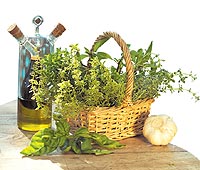" HISTORICAL RECORD "
An important category of the plant kingdom that has a particular status among people of all countries and of all times is the aromatic and pharmaceutical plants. The first because they grant us of their essential oils, the latter because they have therapeutic qualities. From the most ancient times, plants and especially fragrant flowers represent the Creator's artistic touch.
MAY THE FORCE BE WITH YOU Copyright © Demetrios the Traveler
(Brexians lair)
In this way, did Ancient Greeks deify Mother Earth Dimitra, and establish great celebrations, the well-known flower festivals, thanks to the fertility of both nature and flowers. Our ancestors moreover considered their gods as masters in the art of scent making. As Mys from Apollonios refers to (first century BC) in his precise treatise "About Myrrh", scents were very widespread during that time.
Their use was important during festivals, table companions would be sprinkled in scents during banquets wearing aromatic flower wreaths (roses, etc.) and foot cleaning with scents was common.
Our religion is tightly connected to plants and to flowers especially. Jesus Christ described field lilies as nature's most majestic gown. In Christian churches, even to this day flowers constitute the best of decorations. Flowers are also used to decorate tombstones on Good Friday and laurel leaves represent Jesus' magnificent entering in Jerusalem on the last Sunday before Easter. Baptisms, festivals, or weddings, in all happy moments of our life, these flowers are the symbols of happiness and inseparable friends so much so that they even accompany us to the grave.
Ancient Greeks and Romans used almost every well-known aromatic plant and spice, as they were an intrinsic part of life not only for the rich but for the common people too. Aromatic plants were also used to flavour wines whereas expensive spices very desirable presents. Furthermore, the therapeutic qualities of many of these plants were known in the Antiquity. Hippocrates, father of medicine (460-570 BC) believed, that anise stopped sneezes, that coriander prevented stomach disturbances and induced sleep, that thyme was an expectorant, that both matzourana and savory limited bile effusion and that mint kept patients from vomiting. Theophraste (572-287 BC) took interest in these aromatic plants as well as later Dioskouridis the Anaserveas who described the therapeutic qualities of about 600 plants.
Apart from Greeks, other people also took interest in the aromatic plants during the Antiquity. In Asia, a great spice trade was created 6000 to 7000 years before the Chinese, followed by the Arabs who spread it to Europe. Sumerians, one of the world's most ancient peoples, who along with the Assyrians inhabited Mesopotamia knew the therapeutic qualities of about 200 plants among which was coriander, dill, fennel, crocus, oregano, eletaria, thyme and cumin which were used by both doctors and magicians in those days.
In Ancient Babylon apart from the hanging gardens in which many decorative plants were cultivated, there were other vast gardens with aromatic plants for spice production whose profits constituted an important part of the nation's income. Besides, Ancient Egypt was a significant centre of aromatic plant production some of which were even used for the mummification of the dead such as anis, cumin, cinnamon, and possibly matzourana.
Furthermore, aromatic plants were used in religious rituals as well as for food while scents and aromatic creams were used to cure various diseases. The use of perfumes at the time has been proved by the fact that "dried" perfumes were found in Egyptian pyramids. More precisely Indians, Persians, and Egyptians used the distillation method that is the basis of essential oil production for the first time in Eastern civilizations. Details about the steps and the results of such a distillation in Antiquity do not exist. However, the first essential oil that was distillate in a primitive way was turpentine that comes from pine resin. To take the perfume out of flowers, leaves, or roots, the plants were placed in glass vessels which contained very pure animal fat and which were left in the sun for a certain time.
The fat and the plants would then be separated and the result was an aromatic cream or ointment. Many years passed since that ancient era without reference to any noticeable progress in the method of producing essential oil. Consequently, until the beginning of the Middle Ages this method of distillation was mainly used to produce hydrostatics. The first effective description of modern day essential oil distillation was given by the Catalan doctor Arnald de Villanova (1255-1311) who is considered to have developed the distillation technique in diagnosis therapy in Europe. Using heat as a method of separation of the plant's essential oils was both given its terminology and elaborated by the Swiss Bombastus Paracelsus von Hohenheim (1493-1541). In the 18th century many researchers specialised in chemistry studied and described both the nature of essential oils and the methods of elaboration. The scientific chemical revolution which started with Lavoisier's studies (1743-1794) had as an outcome a new approach to the study of the essential oil's nature and reactions.
The essential oil's study continued also during the 19th century and is still evolving nowadays having as a result that most of them have been completely analysed. This happened thanks to the application of improved analyses methods, the most important of them being air and liquid chromatography and density spectrography which were invented in the middle of our century and which are considered a revolution in the field of analytic chemistry.
(Brexians lair)












Δεν υπάρχουν σχόλια:
Δημοσίευση σχολίου